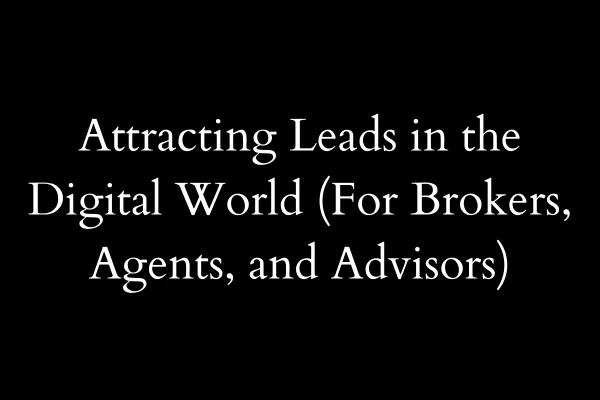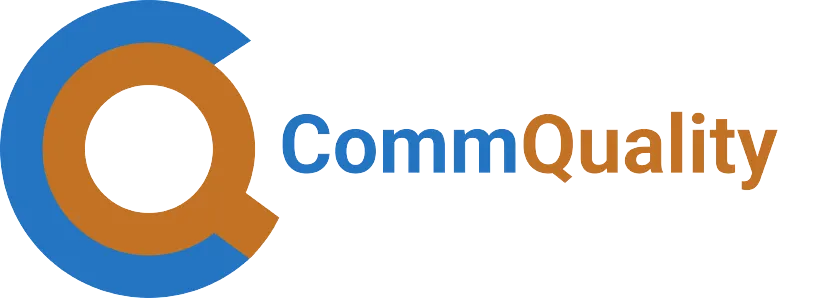
Attracting Leads in the Digital World (For Brokers, Agents, and Advisors)
Understanding the Sales Funnel
The sales funnel is a model that describes the journey a potential client takes from first learning about your business to eventually making a purchase. It's typically divided into three stages:
Traffic: The potential client learns about your business.
Lead Capture: They express interest in your services.
Decision: They consider whether to use your services.
Understanding this funnel can help you create effective strategies for attracting and converting leads.

Attracting Leads
Attracting leads is like fishing - you need the right bait, fishing spot, and techniques to catch a fish. In the context of business, the 'fish' are your potential clients, and the 'bait' is the value you offer to them.
Attracting leads is a multifaceted process that involves understanding where your potential clients are (traffic), engaging them with valuable offerings (lead capture), and convincing them to choose your services (decision). It's a skill that takes time and effort to master, but it's crucial for the growth of your business.
Here are some strategies:
Traffic
Imagine you're a shopkeeper. Your shop is filled with high-quality products, your prices are competitive, and you're ready to provide excellent customer service. But this doesn't matter if your shop is in a deserted alley where no one goes. Traffic, in a business context, is similar to the footfall in a shop. It refers to the people who visit your website, see your advertisements, or come across your business somehow. Without traffic, you won't have any leads to convert into customers.
Now, think about how people could find your shop. They might walk by and see your amazing showcase (organic), you might go out and invite people in (hustler), or you might print and put up advertisements around town to attract customers (paid). Similarly, in the digital world, traffic can come from various sources:
Organic: This includes SEO, blog content, and referrals.
Hustler: This involves proactive strategies like cold calls, emails, and networking.
Paid: This includes digital advertisements, events, and sponsorships.
Each of these sources can play a role in your lead generation strategy, and understanding how to leverage them effectively can help you attract a steady stream of potential clients to your business.
Lead Capture
Now that you've attracted potential customers to your shop (or in the digital world, visitors to your website), the next step is to engage with them. This is like a shopkeeper asking a visitor for their contact information so they can send them updates about new products, sales, or events. In a business context, this process is known as lead capture.
Lead capture is a crucial step in the sales funnel because it allows you to maintain a relationship with potential customers. Even if a visitor doesn't purchase their first visit, capturing their contact information allows you to engage with them over time, build trust, and eventually convert them into customers.
This can be achieved through:
Lead Forms: Forms on your website where potential clients can provide their contact information.
Email Campaigns: Send emails to potential clients to nurture their interest.
Webinars: Offer free webinars to provide value and capture leads.
Calendar Link: Providing a link where potential clients can schedule a consultation.
Free Consultation: Offer a free consultation to attract leads.
Freebie: Offer something of value for free (like an ebook or guide) in exchange for contact information.
Webchat widget: A chat widget on your website makes you easily accessible to visitors.
Decision
You've successfully attracted potential customers to your shop and captured their contact information. Now comes the crucial step - convincing them to make a purchase. This is akin to a shopkeeper explaining the benefits of a product, offering a discount, or providing exceptional customer service to persuade a customer to buy. In a business context, this stage is known as the decision stage.
The decision stage is where potential leads evaluate their options and decide whether or not to avail of your services. It's a critical juncture because it directly impacts your conversion rate - the percentage of leads that become customers.
This can involve:
Your Value Proposition: Explain why a potential client should choose your services.
Closing Meeting: You finalize the deal and your closing ability.
Understanding Need: Demonstrating that you understand and can meet the client's needs.
Additional Part of Offer: Any additional services or benefits you offer.
What Separates You: What makes you different from others?
Price: The cost of your services.
Attracting Leads vs. Buying Leads
While buying leads can seem like a quick way to grow your client base, attracting leads often provides better long-term results. Here's why:
Quality: Attracted leads are often higher quality because they've already shown interest in your services.
Cost-Effectiveness: While attracting leads requires an investment in marketing, it can be more cost-effective in the long run because these leads are more likely to convert.
Sustainability: Attracting leads helps you build a sustainable pipeline of potential clients.
Improved Client Journey: Attracting leads can lead to a better client journey. When leads are attracted to your business, they're more likely to be engaged and satisfied throughout the sales process, which can lead to higher client retention and referrals.
In Summary
Each stage - Traffic, Lead Capture, and Decision - plays a pivotal role in converting a casual visitor into a loyal customer. It's like a well-orchestrated dance where each step is crucial to the performance.
While buying leads can seem like a quick way to grow your client base, attracting leads often provides better long-term results. Attracted leads are usually higher quality because they've already shown interest in your services. Attracting leads is also more cost-effective in the long run because these leads are more likely to convert. Moreover, it helps you build a sustainable pipeline of potential clients, ensuring the longevity of your business.
But the most significant advantage of attracting leads is the improved client journey. When leads are attracted to your business, they're more likely to be engaged and satisfied throughout the sales process. This increases the likelihood of conversion and fosters client loyalty, leading to repeat business and referrals.
Are you ready to take your business to the next level?
We offer a comprehensive lead generation and conversion process that can help you attract high-quality leads and convert them into loyal customers. Plus, as part of our unique proposition, we offer training with the Installment Sale Trust (IST), a specialized service that can provide significant tax benefits for your clients. This unique offering distinguishes our clients from other business brokers, Real estate agents, and financial advisors. The IST adds value for your clients, making your services even more attractive.
Start today to learn how we can help you grow your business for just $19/mo.
Have a quick Question?
Schedule a 5-minute Q&A with one of our IST Advisors
Level Up Your Practice. Let's meet!
Software
CRM
Email Marketing
Website Chat Widget
Automated Outreach & Response
© 2025 CommQuality. All Rights Reserved


